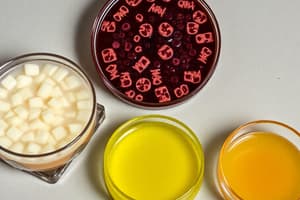Podcast
Questions and Answers
What is the purpose of using culture media in microbiology?
What is the purpose of using culture media in microbiology?
- To prepare biological products like vaccines
- To study the characteristics of microorganisms (correct)
- To identify the type of infection in vivo
- To extract minerals from microorganisms
What is the function of peptone in culture media?
What is the function of peptone in culture media?
- To provide solidifying properties to the media
- To partially digest proteins and supply carbon & nitrogen (correct)
- To supply energy to microorganisms
- To maintain a suitable pH level in the media
Which of the following is NOT a nutrient required for microbial growth?
Which of the following is NOT a nutrient required for microbial growth?
- Vitamin source (correct)
- Carbon source
- Energy source
- Nitrogen source
What is the role of agar in microbiological media?
What is the role of agar in microbiological media?
What temperature range does agar melt and solidify at?
What temperature range does agar melt and solidify at?
Which growth factor is specifically mentioned for E.coli and Salmonella typhi in the text?
Which growth factor is specifically mentioned for E.coli and Salmonella typhi in the text?
What is the agar concentration range in solid media?
What is the agar concentration range in solid media?
Which type of media is used for observing bacterial motility?
Which type of media is used for observing bacterial motility?
What is the distinguishing feature of enriched media?
What is the distinguishing feature of enriched media?
Which type of culture media is composed of both natural and synthetic substances?
Which type of culture media is composed of both natural and synthetic substances?
In which type of culture media are all components and their concentrations known?
In which type of culture media are all components and their concentrations known?
Which type of media supports most non-fastidious bacteria?
Which type of media supports most non-fastidious bacteria?
What is the main purpose of selective media in microbiology?
What is the main purpose of selective media in microbiology?
Which type of media is specifically used for isolating a particular genus of bacteria?
Which type of media is specifically used for isolating a particular genus of bacteria?
How does differential media aid in visual differentiation of bacteria?
How does differential media aid in visual differentiation of bacteria?
In microbiology, what is the primary function of assay media?
In microbiology, what is the primary function of assay media?
Which agar type is known for differentiating E.coli and Salmonella based on lactose fermentation?
Which agar type is known for differentiating E.coli and Salmonella based on lactose fermentation?
Flashcards are hidden until you start studying
Study Notes
Culture Media or Nutrient Media
- Culture media is the food material or substances required for growing microorganisms in vitro (outside the body)
- Uses of culture media:
- To identify the cause of infection from clinical samples
- To study the characteristics or properties of microorganisms
- To prepare biological products like vaccines, toxoids, and antigens
Components of Culture Media
- Nutrients:
- Energy source
- Carbon source
- Nitrogen source
- Mineral salts:
- Sulphates, phosphates, chlorides, and carbonates of K, Mg, and Ca
- pH: 7.2-7.4
- Growth factors:
- Arginine for E. coli
- Tryptophan for Salmonella typhi
- Peptone:
- Partially digested protein with hydrolytic enzymes (pepsin, trypsin)
- Supplies carbon and nitrogen to the media
- Agar:
- Heteropolysaccharides extracted from certain sea red algae
- Used as a solidifying agent in many microbiological media
- Melts at 80-90°C and solidifies at 35-42°C
- Not digestible by any pathogenic bacteria
Classification of Culture Media
Based on Consistency
- Solid media:
- Contain 1.5-2.5% agar
- Useful for the isolation, colony characteristic, and identification of bacteria
- Examples: Nutrient agar, MacConkey agar
- Semi-solid media:
- Contain 0.3-0.5% agar
- For the observation of bacterial motility and preservation of bacteria
- Examples: Manitol
- Liquid or broth media:
- Without agar
- For the proliferation of bacteria (activation of microorganisms)
- Examples: Nutrient broth, MacConkey broth
Based on Chemical Components
- Natural medium:
- Composed of natural products
- Chemical compositions are unknown
- Examples: Urine, milk, vegetable, blood
- Semi-synthetic medium:
- Composed of natural and synthetic substances
- Examples: PDA (Potato Dextrose Agar)
- Artificial or synthetic media:
- All components and their concentrations are known
- Examples: MacConkey agar
Based on Functional Aspect
- General purpose media (Basal media or ordinary media):
- Support most non-fastidious bacteria
- Examples: Peptone water, nutrient broth, and nutrient agar
- Enriched media:
- Addition of extra nutrients to basal medium
- Used to grow fastidious bacteria
- Examples: Blood agar, chocolate agar
- Selective media:
- Allow the growth of certain type of organisms, while inhibiting the growth of other organisms
- Examples: Salmonella-Shigella Agar (SSA)
- Differential media:
- Special substrates and indicators are added to produce a visual differentiation
- Examples: MacConkey agar, Eosin Methylene Blue (EMB) agar
- Specialized media:
- Used for isolation of specific genus of bacteria
- Examples: TCBS (Thiosulphate Citrate Bile salt Sucrose) Agar for isolation Vibrio cholera
- Assay media:
- Used for sensitivity test (antibiotic, amino acid, vitamins)
- Examples: Mueller Hinton Agar
Studying That Suits You
Use AI to generate personalized quizzes and flashcards to suit your learning preferences.



